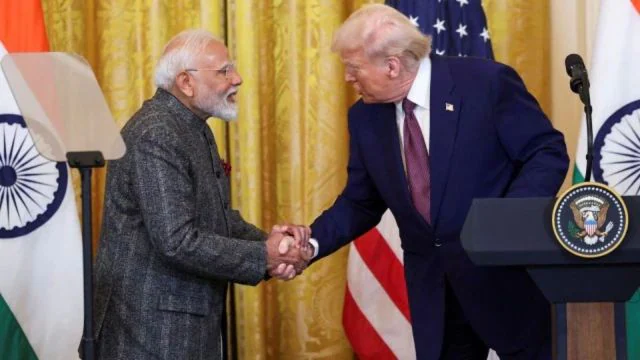Delhi’s Outstretched Hand, Crossed Fingers: India’s High-Stakes Wait on Washington

Image via The Indian Express
Date: September 7, 2025
New Delhi has stretched its hand toward Washington. But at the same time, it keeps its fingers tightly crossed. This image of hope mixed with caution sums up the current state of India-US relations.
The situation is not about symbolic gestures alone. It reflects deep trade talks, high-level diplomacy, and the wait for a clear political signal. Delhi wants a stronger partnership with the United States, but it also knows that the road ahead is filled with uncertainty.
A Silent But Strong Move
Indian officials have made a clear choice. They are not reacting to every sharp word that comes out of Washington. Over the past weeks, many comments from US leaders—including Donald Trump, his adviser Peter Navarro, and Commerce Secretary Lutnick—have been loud and critical. They have spoken of trade imbalances and tough negotiations.
But Delhi has chosen silence. It is not replying to each remark. This silence is not weakness. It is, in fact, a tool. By staying quiet, Delhi avoids unnecessary fights. It saves energy for the real goal—a trade deal that works for both sides.
Why Silence Matters
Experts call this approach “quiet diplomacy.” It may not grab headlines, but it speaks louder than words. By not responding, India signals that it does not want a war of words. Instead, it wants solutions.
Indian diplomats believe that if they answer every jibe, they would only worsen the atmosphere. Anger on both sides could derail talks. Silence, on the other hand, leaves space for calm discussions.
This choice also shows confidence. India is not desperate to please. It is patient. It is ready to wait for the right time and the right deal.
The Pressure on Negotiators
Behind this calm face, however, there is pressure. Trade negotiators from both countries are under heavy stress. They must close the talks soon. Every day of delay raises doubt. Will the deal happen? Or will it fail, pushing ties backward?
In Delhi, officials are keeping their fingers crossed. They know that the outcome of these talks will shape the next steps. If the deal is sealed, bigger things can follow. If not, the silence may not be enough to save goodwill.
Why This Deal Matters
The trade agreement is more than just about goods, tariffs, or markets. It carries symbolic weight. For India, it will show that Washington is ready to respect its concerns. For the United States, it will prove that India remains a reliable partner.
Most importantly, a deal could open the door for a historic visit. There is talk that the US President may attend the upcoming Quad leaders’ summit in Delhi. Such a visit would be seen as a turning point. It would mark the revival of ties that have been tense for some time.
Delhi’s Balancing Act
Why do we see both an outstretched hand and crossed fingers at the same time? Because Delhi is playing a careful game. On one hand, it wants to show goodwill. It is ready to welcome Washington. On the other hand, it is realistic. It knows that American politics can be unpredictable.
Trump’s style of negotiation is direct, sometimes harsh. He prefers public pressure. India understands this. That is why it does not overreact. It stays on course, waiting for concrete progress rather than empty words.
What Comes Next?
If negotiators reach an agreement, the mood will change fast. Delhi will be ready to host the US President. That will not just be a ceremony. It will mean that India and the United States are again moving closer, both strategically and economically.
Such a moment would strengthen the Quad partnership as well, which also includes Japan and Australia. Together, these countries hope to keep the Indo-Pacific region stable and secure.
But if talks fail, the silence could turn into frustration. Delhi will have to rethink its strategy. Without a deal, trust will remain shaky. High-level meetings may get delayed. Fingers will remain crossed even longer.
The Broader Picture
India’s choice of patience reflects a larger reality. Global politics today is not simple. Every country is protecting its own interests more strongly than before. Alliances shift quickly.
In this climate, India wants to appear steady. By reaching out to Washington without overcommitting, it keeps its options open. It shows the world that it is mature and strategic.
At the same time, it cannot ignore the risks. Trade is linked with jobs, investment, and growth. A wrong step could hurt the Indian economy. That is why caution remains at the heart of its moves.
Conclusion
Delhi’s outstretched hand shows hope. Its crossed fingers show worry. The two gestures together explain India’s current diplomacy. It wants a deal with Washington. It is ready for friendship. But it knows that the outcome is not in its hands alone.
For now, Delhi waits. It keeps calm. It leaves the heavy lifting to negotiators. The world watches closely. Will the handshake happen? Or will crossed fingers remain the only sign of hope?